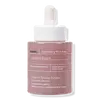What's inside
What's inside
 Key Ingredients
Key Ingredients

 Benefits
Benefits

 Concerns
Concerns

 Ingredients Side-by-side
Ingredients Side-by-side

Water
Skin ConditioningAscorbic Acid
AntioxidantCyclohexasiloxane
EmollientGlycerin
HumectantAlcohol Denat.
AntimicrobialPotassium Hydroxide
BufferingPolymethylsilsesquioxane
Polysilicone-11
Dimethicone
EmollientPropylene Glycol
HumectantPentaerythrityl Tetraethylhexanoate
EmollientC13-14 Isoparaffin
EmollientTocopherol
AntioxidantSodium Hyaluronate
HumectantHydrolyzed Hyaluronic Acid
HumectantAdenosine
Skin ConditioningAcetyl Dipeptide-1 Cetyl Ester
Skin ConditioningPEG-20 Methyl Glucose Sesquistearate
EmulsifyingPoloxamer 338
EmulsifyingSalicylic Acid
MaskingPolyacrylamide
Toluene Sulfonic Acid
Ammonium Polyacryloyldimethyl Taurate
Emulsion StabilisingXanthan Gum
EmulsifyingCaprylyl Glycol
EmollientDisodium EDTA
BHT
AntioxidantLaureth-7
EmulsifyingParfum
MaskingWater, Ascorbic Acid, Cyclohexasiloxane, Glycerin, Alcohol Denat., Potassium Hydroxide, Polymethylsilsesquioxane, Polysilicone-11, Dimethicone, Propylene Glycol, Pentaerythrityl Tetraethylhexanoate, C13-14 Isoparaffin, Tocopherol, Sodium Hyaluronate, Hydrolyzed Hyaluronic Acid, Adenosine, Acetyl Dipeptide-1 Cetyl Ester, PEG-20 Methyl Glucose Sesquistearate, Poloxamer 338, Salicylic Acid, Polyacrylamide, Toluene Sulfonic Acid, Ammonium Polyacryloyldimethyl Taurate, Xanthan Gum, Caprylyl Glycol, Disodium EDTA, BHT, Laureth-7, Parfum
Water
Skin ConditioningCaprylic/Capric Triglyceride
MaskingAscorbyl Tetraisopalmitate
AntioxidantRosa Canina Fruit Oil
EmollientGlycerin
HumectantSqualane
EmollientTocopheryl Acetate
AntioxidantBisabolol
MaskingDictyopteris Polypodioides Extract
EmollientEthylhexylglycerin
Skin ConditioningHelianthus Annuus Seed Oil
EmollientLactic Acid
BufferingLonicera Caprifolium Flower Extract
PerfumingLonicera Japonica Flower Extract
Skin ConditioningMelia Azadirachta Extract
Skin ConditioningMoringa Oleifera Seed Oil
EmollientPancratium Maritimum Extract
BleachingPanthenol
Skin ConditioningRosa Damascena Flower Oil
MaskingRosmarinus Officinalis Extract
AntimicrobialSodium Chloride
MaskingTocopherol
AntioxidantZingiber Officinale Root Extract
MaskingPotassium Sorbate
PreservativeSodium Benzoate
MaskingCitronellol
PerfumingGeraniol
PerfumingLinalool
PerfumingWild Boar Oil
HumectantWater, Caprylic/Capric Triglyceride, Ascorbyl Tetraisopalmitate, Rosa Canina Fruit Oil, Glycerin, Squalane, Tocopheryl Acetate, Bisabolol, Dictyopteris Polypodioides Extract, Ethylhexylglycerin, Helianthus Annuus Seed Oil, Lactic Acid, Lonicera Caprifolium Flower Extract, Lonicera Japonica Flower Extract, Melia Azadirachta Extract, Moringa Oleifera Seed Oil, Pancratium Maritimum Extract, Panthenol, Rosa Damascena Flower Oil, Rosmarinus Officinalis Extract, Sodium Chloride, Tocopherol, Zingiber Officinale Root Extract, Potassium Sorbate, Sodium Benzoate, Citronellol, Geraniol, Linalool, Wild Boar Oil
 Reviews
Reviews

Ingredients Explained
These ingredients are found in both products.
Ingredients higher up in an ingredient list are typically present in a larger amount.
Glycerin is already naturally found in your skin. It helps moisturize and protect your skin.
A study from 2016 found glycerin to be more effective as a humectant than AHAs and hyaluronic acid.
As a humectant, it helps the skin stay hydrated by pulling moisture to your skin. The low molecular weight of glycerin allows it to pull moisture into the deeper layers of your skin.
Hydrated skin improves your skin barrier; Your skin barrier helps protect against irritants and bacteria.
Glycerin has also been found to have antimicrobial and antiviral properties. Due to these properties, glycerin is often used in wound and burn treatments.
In cosmetics, glycerin is usually derived from plants such as soybean or palm. However, it can also be sourced from animals, such as tallow or animal fat.
This ingredient is organic, colorless, odorless, and non-toxic.
Glycerin is the name for this ingredient in American English. British English uses Glycerol/Glycerine.
Learn more about GlycerinTocopherol (also known as Vitamin E) is a common antioxidant used to help protect the skin from free-radicals and strengthen the skin barrier. It's also fat soluble - this means our skin is great at absorbing it.
Vitamin E also helps keep your natural skin lipids healthy. Your lipid skin barrier naturally consists of lipids, ceramides, and fatty acids. Vitamin E offers extra protection for your skin’s lipid barrier, keeping your skin healthy and nourished.
Another benefit is a bit of UV protection. Vitamin E helps reduce the damage caused by UVB rays. (It should not replace your sunscreen). Combining it with Vitamin C can decrease sunburned cells and hyperpigmentation after UV exposure.
You might have noticed Vitamin E + C often paired together. This is because it is great at stabilizing Vitamin C. Using the two together helps increase the effectiveness of both ingredients.
There are often claims that Vitamin E can reduce/prevent scarring, but these claims haven't been confirmed by scientific research.
Learn more about TocopherolWater. It's the most common cosmetic ingredient of all. You'll usually see it at the top of ingredient lists, meaning that it makes up the largest part of the product.
So why is it so popular? Water most often acts as a solvent - this means that it helps dissolve other ingredients into the formulation.
You'll also recognize water as that liquid we all need to stay alive. If you see this, drink a glass of water. Stay hydrated!
Learn more about Water